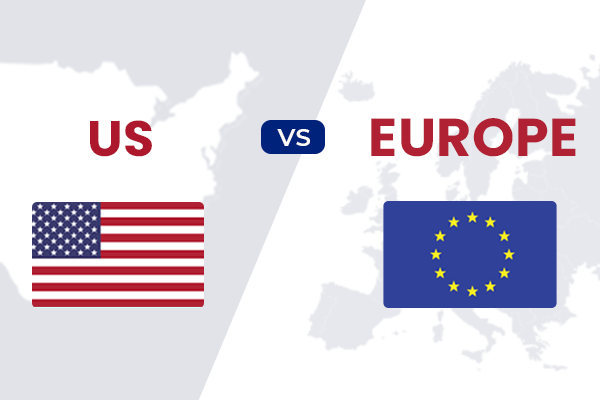The decision to study abroad is life-changing, offering opportunities for academic growth, cultural exploration, and career development. Among the most popular destinations for international students are the USA and Europe. Both regions offer world-class education, but they differ significantly in terms of academic structure, cost, lifestyle, and career prospects. This blog explores these differences to help you make an informed choice.
Academic Structure and Approach
USA:
The USA is known for its flexible education system. Undergraduate programs typically last four years, with the first two years allowing students to explore various subjects before declaring a major. This flexibility appeals to students who are unsure of their career path or wish to explore diverse academic interests. Graduate programs focus on research and practical applications, often emphasizing innovation.
Europe:
Europe offers a more specialized approach. Undergraduate programs usually last three years and are highly focused on a specific field of study. This system is ideal for students who are clear about their career goals and prefer a streamlined academic experience. Graduate programs are equally rigorous, often emphasizing theoretical knowledge and research.
Cost of Education
USA:
Studying in the USA is often associated with high tuition fees. Public universities, especially for out-of-state and international students, can cost between $20,000 and $40,000 annually, while private universities may exceed $50,000 per year. However, the USA offers a wide range of scholarships, grants, and work-study opportunities to help offset these costs.
Europe:
Europe, on the other hand, is known for its affordable education. Many countries, such as Germany, Norway, and Finland, offer free or low-cost tuition, even for international students. Even in countries where fees are required, such as the UK or the Netherlands, costs are often lower than those in the USA. Additionally, Europe provides numerous scholarship programs.


Cultural Experience and Lifestyle
USA:
The USA is a melting pot of cultures, offering a vibrant and diverse student life. Campuses are typically equipped with state-of-the-art facilities, including libraries, gyms, and cultural centers. American universities emphasize extracurricular activities, sports, and networking opportunities, making campus life dynamic and engaging.
Europe:
Europe offers a rich cultural heritage and a unique opportunity to experience different countries and cultures within a short distance. The Schengen visa allows students to travel across 27 European countries, making weekends and holidays perfect for exploring new destinations. European universities often have smaller, community-oriented campuses, and students are encouraged to engage with local culture.
Career Opportunities
USA:
The USA is home to some of the world’s largest companies and innovation hubs, making it an attractive destination for students seeking global career opportunities. International students can work on-campus and may be eligible for Optional Practical Training (OPT), allowing them to work in their field of study for up to three years after graduation.
Europe:
Europe offers excellent career opportunities, particularly in industries like engineering, finance, healthcare, and design. Many countries allow international students to stay and work after graduation, with visa policies varying by nation. For instance, Germany offers an 18-month post-graduation work visa, while the UK provides a two-year graduate route visa.


Language and Accessibility
USA:
English is the primary language of instruction in the USA, making it an easy transition for students fluent in English. However, adjusting to the American accent and slang may take time.
Europe:
While many European universities offer programs in English, students may need to learn the local language for day-to-day interactions. This requirement can be an added challenge but also an opportunity to become multilingual.
Conclusion
Choosing between the USA and Europe ultimately depends on your academic goals, budget, and personal preferences. If you value flexibility, innovation, and vibrant campus life, the USA might be the right fit. However, if affordability, cultural diversity, and travel opportunities appeal to you, Europe could be your ideal destination. Both regions offer unparalleled opportunities for growth and success—your decision should align with your aspirations and priorities.
